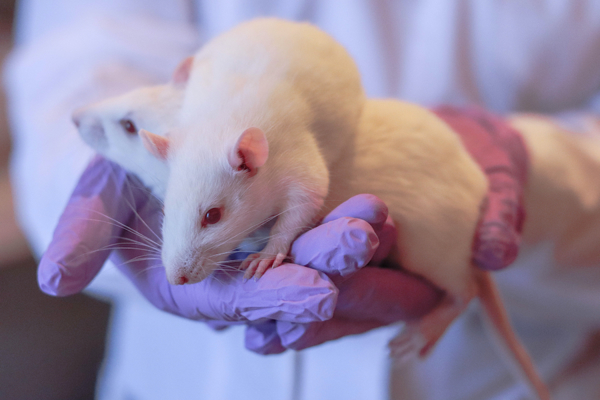
Is it possible to use stem cells from a relative to cure a spinal cord injury?
November 10, 2006

- Related Topics:
- Futuristic science,
- Bioethics,
- Stem cells,
- Biotechnology
A curious adult from Arizona asks:
"Is there a possibility of using stem cells from a relative’s umbilical cord to use for spinal cord cell cure treatment? I saved my niece’s umbilical cord last year hoping there would be a day to use for a cure for my spinal cord injury or if my niece ever has a use for it."
One day this sort of thing might be possible. In fact, there is even a claim that this very strategy has worked in South Korea.
A woman who had been a paraplegic for 19 years received matched umbilical cord stem cells. According to the scientists who did the work, within six weeks she could walk with a walker.
But after a second operation her condition worsened. And now she complains of severe pain.
South Korean scientists have repeated the experiment on other patients. Some of these patients complained of complications. Others had mild improvements.
Another procedure has been done on people using stem cells from a patient's nose. Why nose stem cells?
Well, nerve stem cells are incredibly rare. The only ones that are easy to get are found in the nose (they're used for our sense of smell).
Dr. Carlos Lima of Portugal has treated over 30 different spinal cord patients with their own nose stem cells. (Actually these cells are called olfactory ensheathing and stem-like progenitor cells, but we'll keep calling them nose stem cells.)
These patients have made definite improvements and so the results are encouraging. As long as it is safe and the effects last that is. Like the work done in South Korea, this work is at a very early stage.
Too early, really. It was almost certainly not a good idea to start human experiments quite yet.
Before starting on people, these scientists should have done more work in animals first. And this is what other scientists are doing.

Animal studies on stem cells
Why, you might ask, should they be doing animal studies first? Don't we want to help people who are suffering right now?
Well, yes. But we want to make sure the therapy really works. And we want to make sure it is safe. Animal studies can help us figure this out.
For example, it might be that stem cells work at first and then stop working. Or the stem cells might develop into cancer.
Cancer is caused by cells that can continuously grow, which makes them similar to stem cells. Scientists want to make sure that, when stem cells are inserted into a body, they stay where they are supposed to and don't end up growing uncontrollably, like cancer cells do.
All of these things would be better to figure out in animals first. And the early results from animal experiments are encouraging.
Embryonic stem cells
Let's start with the most controversial experiments -- those using embryonic stem cells. Embryonic stem cells are said to hold the most promise because they can become any other kind of cell.
So why isn't everyone using embryonic stem cells? Because their use has major ethical and medical issues.
Right now, an embryo needs to be destroyed to obtain embryonic stem cells. Anyone who considers an embryo to be a life is going to be troubled by this.
In the near future, scientists will probably be able to get these cells without destroying the embryo. We aren't there yet, though.
And even if we overcome this ethical problem, we still have the problem of tissue rejection. Embryonic stem cells may not genetically match the paralyzed person. If this is the case, then the body will reject them.
In the future, rejection may not be a big issue for embryonic stem cells either. People may be able to make embryos from themselves and harvest their own embryonic stem cells.
Of course, they'll have to either destroy the embryo or make a clone of themselves. So the ethical dilemma will likely be here for years to come!
So real therapies with embryonic stem cells are still a ways off. But like I said, the early work in animals is very encouraging.
For example, a group at UC Irvine has managed to use human embryonic stem cells to treat rats with spinal cord injuries.1 And after a year the rats are still OK.
But it only works on recently injured rats. A rat with a 7 day old spinal injury was helped. One with a 10 month old spinal injury was not.
In other words, the work they're doing might not help people who injured their spine years ago. And this line of research still suffers from ethical and rejection problems.

Adult stem cells
Besides embryonic stem cells, scientists are also doing animal studies with adult stem cells. Some of these experiments are showing promise as well.
We've already talked about a couple of these stem cells that were used in human studies. But wait a minute. Aren't umbilical cord stem cells the same thing as embryonic stem cells? No.
Umbilical cord stem cells are adult stem cells, because they come from a fully developed human instead of an early embryo. You can see why scientists don't like calling these cells “adult.” They prefer the term somatic. More of a mouthful, but you don't have to deal with fetal stem cells being called “adult.”
Anyway, adult stem cells don't have any real ethical problems. Rejection problems are less significant too.
The umbilical cord stem cells can come from a relative decreasing the chance for rejection. And other adult stem cells (like the ones in the nose) can come from the patients themselves. No rejection risk there!
Early animal work suggests that adult stem cells might be an alternative to embryonic stem cells. People are finding nerve-like cells in umbilical cord stem cells. They are also finding that when these cells are put into the spinal cord environment, they can turn into nerve stem cells.
Studies using both nose and umbilical cord stem cells have shown that the cells went to the injury and turned into some nerve cells. A number of studies showed some improvement and some did not. The early safety data looks promising as well.
So lots of work is being done on treating spinal cord injury with stem cells. The most promising results are those with embryonic stem cells in animals. But some of the early work with adult stem cells is looking promising as well.
The stem cells aren't turning into cancers. They are staying at the site of the injury and turning into nerve cells. And some scientists are starting to do proper safety studies in people as well.
This is all very encouraging. Perhaps sooner rather than later stem cells will be used to help heal injured spinal cords.

Author: Dr. D. Barry Starr
Barry served as The Tech Geneticist from 2002-2018. He founded Ask-a-Geneticist, answered thousands of questions submitted by people from all around the world, and oversaw and edited all articles published during his tenure. AAG is part of the Stanford at The Tech program, which brings Stanford scientists to The Tech to answer questions for this site, as well as to run science activities with visitors at The Tech Interactive in downtown San Jose.
 Skip Navigation
Skip Navigation
